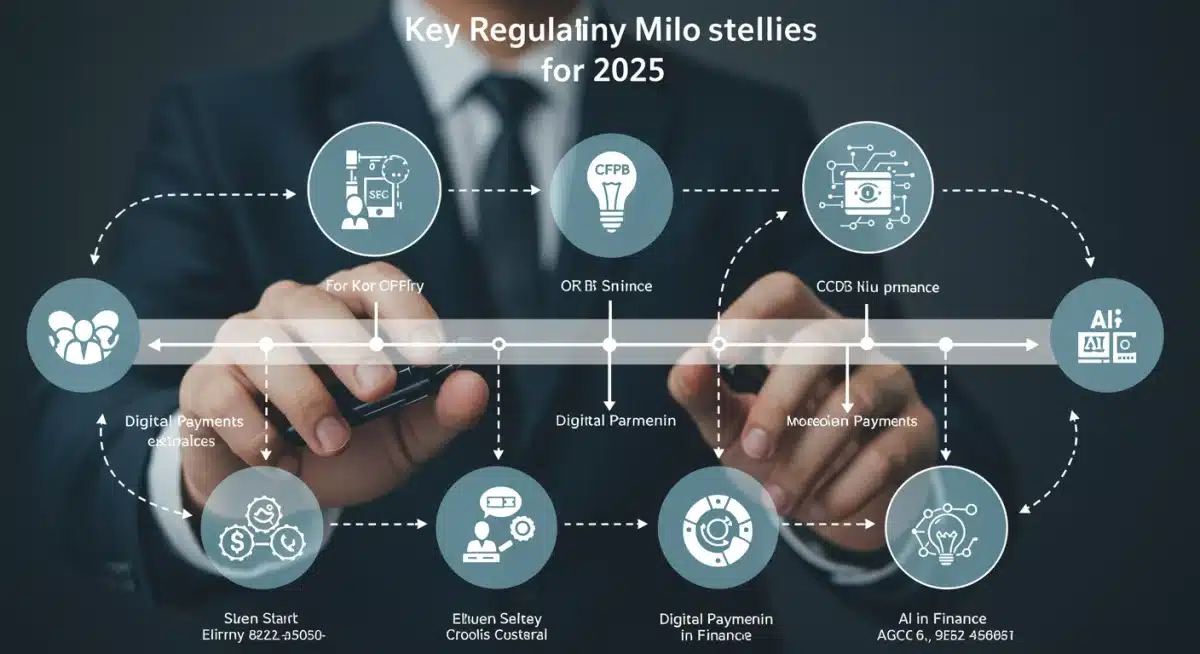Navigating 2025 FinTech Regulations in the U.S.

Navigating the 2025 Regulatory Landscape for U.S. Financial Technology Companies is becoming a paramount concern for industry leaders and innovators alike. As the calendar pages turn, the U.S. FinTech sector braces for a wave of new regulations set to redefine operational frameworks and compliance obligations. What do these impending changes mean for your business?
Understanding the Evolving Regulatory Environment
The U.S. financial technology landscape is in a constant state of flux, driven by rapid innovation and increasing calls for consumer protection and market stability. The year 2025 is poised to bring significant shifts, with regulators focusing on areas previously left largely untamed. These developments are not just minor adjustments; they represent a fundamental rethinking of how FinTech operates within the broader financial system.
Recent pronouncements from key agencies, including the Securities and Exchange Commission (SEC) and the Consumer Financial Protection Bureau (CFPB), signal a more proactive approach to oversight. This will encompass everything from digital asset trading to AI-driven lending models. Understanding the nuances of these evolving frameworks is critical for any company operating in this space.
Key Regulatory Bodies and Their Focus
Several federal agencies are spearheading these changes, each with specific mandates that directly impact FinTech operations. Their coordinated, and sometimes overlapping, efforts create a complex web of compliance requirements.
- SEC: Primarily concerned with investor protection and market integrity, the SEC is intensifying its scrutiny of digital asset offerings and trading platforms, viewing many as securities.
- CFPB: Focused on consumer protection, the CFPB is targeting predatory lending practices, data privacy, and transparency in FinTech products, especially those impacting vulnerable populations.
- OCC: The Office of the Comptroller of the Currency is looking at how FinTechs integrate with traditional banking, particularly concerning chartering and oversight for novel banking services.
Digital Assets and Blockchain: A New Era of Oversight
The burgeoning digital asset market, encompassing cryptocurrencies, NFTs, and tokenized securities, is a primary target for 2025 regulatory updates. Regulators are moving past initial exploratory phases to implement concrete rules aimed at mitigating risks associated with volatility, fraud, and illicit finance. This involves clarifying legal classifications and establishing robust supervision.
Companies involved in issuing, trading, or custodying digital assets must prepare for heightened disclosure requirements, capital adequacy standards, and stringent anti-money laundering (AML) and know-your-customer (KYC) protocols. The goal is to bring these innovative financial instruments under a regulatory umbrella that mirrors, or even exceeds, traditional financial safeguards.
Impact on Decentralized Finance (DeFi)
Decentralized Finance (DeFi) platforms, often operating with minimal centralized control, face particular challenges. Regulators are grappling with how to apply traditional financial laws to these novel structures. Expect increased pressure for DeFi projects to identify responsible parties and implement mechanisms for compliance, even if the underlying technology aims for decentralization.
The SEC, for instance, has indicated a strong interest in how DeFi lending and exchange protocols function, signaling that many could fall under existing securities laws. This could necessitate significant re-architecture or operational changes for platforms to remain compliant within the U.S. market.
Consumer Protection and Data Privacy Enhancements
Consumer protection remains a cornerstone of U.S. financial regulation, and 2025 will see significant enhancements tailored to the FinTech sector. The CFPB, in particular, is pushing for greater transparency, fairness, and accountability in how FinTech companies interact with their users. This includes stricter rules around data collection, usage, and sharing.
New data privacy regulations, potentially building on frameworks like the California Consumer Privacy Act (CCPA), are anticipated at a federal level. These will likely impose broader obligations on FinTechs regarding consent, data security, and consumer rights to access and delete their personal financial information. The emphasis is on empowering consumers and preventing misuse of their sensitive data.

Strengthening Data Security Protocols
With the rise of cyber threats, robust data security is no longer just good practice; it is a regulatory imperative. FinTech companies will face more prescriptive requirements for safeguarding customer data, including mandatory breach reporting protocols and regular security audits. The expectation is a proactive, rather than reactive, approach to cybersecurity.
- Mandatory Breach Reporting: Shorter timelines for reporting data breaches to affected customers and relevant authorities are expected, increasing transparency and accountability.
- Enhanced Encryption Standards: New guidelines may mandate specific encryption levels for data both in transit and at rest, protecting sensitive financial information from unauthorized access.
- Third-Party Vendor Oversight: FinTechs will be held more accountable for the data security practices of their third-party vendors and service providers, necessitating rigorous due diligence.
Artificial Intelligence and Machine Learning in Finance
The increasing integration of Artificial Intelligence (AI) and Machine Learning (ML) into financial services presents both immense opportunities and significant regulatory challenges. Regulators are keenly aware of the potential for algorithmic bias, lack of transparency, and systemic risks introduced by complex AI models. 2025 will see initial frameworks emerge to govern the ethical and responsible use of AI in FinTech.
These regulations will likely focus on ensuring fairness in lending decisions, preventing discriminatory outcomes, and requiring explainability for AI-driven processes. Companies deploying AI in critical financial functions will need to demonstrate that their algorithms are unbiased, transparent, and regularly validated to ensure accuracy and compliance.
Addressing Algorithmic Bias
Algorithmic bias is a major concern, particularly in credit scoring, fraud detection, and insurance underwriting. New rules will aim to prevent AI systems from perpetuating or exacerbating existing societal biases. This could involve mandatory bias audits, diverse training datasets, and independent evaluations of AI model fairness.
The goal is to ensure that AI-powered FinTech solutions serve all populations equitably. Companies will need to invest in robust testing and monitoring frameworks to identify and mitigate biases before they impact consumers. Failure to do so could result in significant penalties and reputational damage.
Payments Modernization and Interoperability
The U.S. payment system is undergoing a significant modernization effort, with 2025 likely to see further advancements and regulatory implications. The push for faster payments, greater interoperability, and enhanced security continues to shape policy. FinTechs specializing in payments will need to adapt to new standards and potentially new oversight mechanisms.
Expect continued emphasis on instant payment rails, such as FedNow, and regulatory efforts to foster greater competition and efficiency among payment providers. This includes discussions around open banking initiatives, which could mandate data sharing between financial institutions and authorized third-party FinTechs, subject to strong consumer consent and data security.
The Rise of Open Banking
Open banking, while still nascent in the U.S. compared to other regions, is gaining traction. Legislation or regulatory guidance in 2025 could accelerate its adoption, requiring banks to securely share customer financial data with FinTechs, with consumer permission. This would unlock new opportunities for personalized financial services but also introduce complex data governance and API security challenges.
- Standardized APIs: Regulators may push for standardized Application Programming Interfaces (APIs) to ensure seamless and secure data exchange across the financial ecosystem.
- Enhanced Consent Mechanisms: Clear and granular consumer consent mechanisms will be paramount, giving individuals full control over who accesses their financial data and for what purpose.
- Data Portability: Consumers may gain greater rights to port their financial data between different service providers, fostering competition and innovation.
Strategic Compliance and Future-Proofing for FinTechs
For U.S. FinTech companies, proactive and strategic compliance will be essential for success in 2025. Simply reacting to new rules as they emerge will no longer suffice. Instead, a forward-looking approach that integrates regulatory considerations into product development, operational planning, and business strategy is required. This involves more than just legal review; it demands a cultural shift towards embedded compliance.
Companies should conduct thorough risk assessments, invest in compliance technology, and foster strong relationships with regulatory bodies. Engaging with industry associations and participating in policy discussions can also provide valuable insights and influence future regulatory directions. The ability to adapt quickly and demonstrate a commitment to responsible innovation will be a key differentiator.
Building a Robust Compliance Framework
Developing a robust compliance framework involves several critical components that go beyond basic legal adherence. It requires a holistic view of operations and a commitment from leadership.
- Dedicated Compliance Teams: Establishing or expanding dedicated compliance teams with expertise in both financial regulation and technology is crucial.
- Automated Compliance Tools: Leveraging AI and machine learning for compliance monitoring, reporting, and risk assessment can significantly enhance efficiency and accuracy.
- Regular Training and Education: Ensuring all employees, from engineers to executives, are aware of their regulatory obligations and the importance of compliance.
- Scenario Planning: Developing contingency plans for various regulatory outcomes and market shifts to maintain operational resilience.
| Key Regulatory Area | Brief Description of Impact |
|---|---|
| Digital Assets | Increased scrutiny, clearer classifications, and enhanced AML/KYC for cryptocurrencies and tokenized securities. |
| Consumer Protection | Stricter rules on data privacy, transparency, and fairness in FinTech products, guided by CFPB initiatives. |
| AI and ML Governance | Emerging frameworks to address algorithmic bias, transparency, and ethical use of AI in financial services. |
| Payments Modernization | Focus on faster payments, interoperability, and potential open banking mandates to enhance efficiency. |
Frequently Asked Questions About 2025 FinTech Regulations
FinTechs face challenges including adapting to evolving digital asset regulations, ensuring robust consumer data privacy, mitigating algorithmic bias in AI, and navigating new payment system requirements, all while maintaining innovation and growth.
Cryptocurrency companies will likely encounter stricter classification of digital assets, increased AML/KYC obligations, and enhanced reporting requirements, potentially leading to significant operational adjustments and compliance costs.
The CFPB will continue to champion consumer protection, focusing on transparency, fairness, and responsible data handling within FinTech products. Expect new rules targeting predatory practices and enhancing data security measures.
Yes, 2025 anticipates the emergence of frameworks to govern AI and ML, particularly addressing algorithmic bias, requiring explainability for decisions, and ensuring ethical deployment to prevent discriminatory outcomes in financial products.
Open banking enables secure data sharing between banks and authorized FinTechs with consumer consent. It could foster innovation and competition but also demands robust API security and clear consent mechanisms for FinTechs.
What Happens Next
As the U.S. FinTech sector moves closer to 2025, the onus is on companies to not just monitor, but actively prepare for, the impending regulatory shifts. The current landscape suggests a move towards more comprehensive oversight, aiming to balance innovation with systemic stability and consumer protection. Companies that proactively adapt their operations, invest in robust compliance infrastructure, and engage constructively with regulators will be best positioned to thrive. Expect ongoing dialogue between industry and government as these frameworks solidify, underscoring the dynamic nature of this critical period for financial technology.





